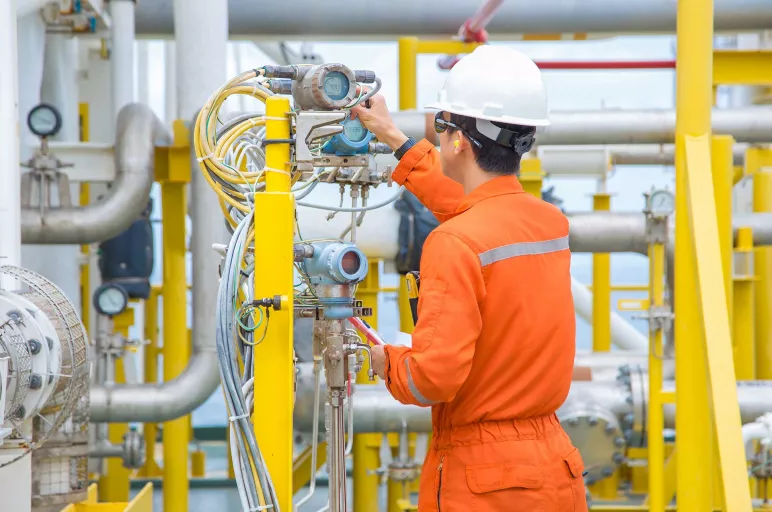Precision is essential in modern industry, whether in oil refineries or beverage plant, and accurate level measurement is crucial. Level transmitters play a vital role by providing critical data that enhances efficiency and safety in industrial operations, supporting engineers, plant managers, and technicians alike.
Table of Contents
Understanding Level Transmitters
Level transmitters are devices used to measure the level of a substance—typically liquids, but also powders or granular materials—in a container. These devices convert the level data into a signal that can be transmitted to a control system. The signal can then be used for process monitoring, control, and automation.
Types of Level Transmitters
- Differential Pressure Level Transmitters: Utilize pressure differences to determine the level of material. They’re popular in industries needing precise measurement.
- Ultrasonic Level Transmitters: Emit ultrasonic waves to measure the distance to the surface of the material. Ideal for non-contact applications.
- Radar Level Transmitters: Use microwave radar waves, offering reliability, especially in harsh conditions.
Each type of level transmitter has unique qualities that lend them to specific applications. Understanding these differences is crucial for selecting the right tool for any given job.
Applications in Modern Industry
From ensuring the efficient operation of a water treatment facility to optimizing chemical production, level transmitters have various critical applications across industries.
Oil and Gas
In oil and gas, precise level measurement is crucial for safety and efficiency. Level transmitters help in monitoring tanks, preventing spills, and ensuring optimal throughput.
Water Treatment
In water treatment plants, level transmitters ensure reservoir levels are maintained, preventing overflow while optimizing water distribution.
Food and Beverage
Level transmitters regulate ingredient mixing and maintain consistent quality across batches in the food and beverage industry, ensuring each product meets safety standards.
By applying level transmitters in these diverse ways, industries can streamline operations, reduce waste, and maintain safety protocols.
Benefits of Level Transmitters
The advantages of using level transmitters are manifold, impacting both the bottom line and operational safety.
Efficiency Improvements and Cost Savings
Accurate level measurements help optimize processes, reduce waste, and lower operational costs. Real-time data allows for timely adjustments, minimizing downtime.
Safety and Compliance
Level transmitters provide assurance in meeting safety standards and environmental regulations. Early detection of anomalies prevents accidents, protecting both personnel and the environment.
Reliability and Precision
With improved precision and reliability, level transmitters offer confidence in managing complex systems, crucial for maintaining operational integrity.
These benefits highlight why integrating level transmitters into industrial processes is not just advantageous but essential for modern operations.
Choosing the Right Level Transmitter
Selecting the appropriate level transmitter involves several considerations to ensure compatibility and efficiency.
Environmental Factors
Consider the environment where the transmitter will be installed. Temperature extremes, pressure variations, and corrosive materials all influence transmitter choice.
Material Compatibility
Material properties, such as viscosity and dielectric constant, affect measurement accuracy and should guide the selection, like those available in APG.
Accuracy and Range
Identify the required accuracy and range for the application. Different transmitters offer varying levels of precision, impacting their suitability.
Choosing the right level transmitter is a decision that requires a thorough understanding of these factors to ensure optimal performance.
Installation and Maintenance Best Practices
Proper installation and maintenance are vital to the longevity and accuracy of level transmitters.
Guidelines for Installation
Ensure the transmitter is installed in a location that avoids obstacles, turbulence, and interference. Correct positioning affects measurement reliability.
Routine Calibration
Regular calibration checks are necessary to maintain measurement accuracy. Calibration ensures that the transmitter continues to perform reliably over time.
Maintenance Protocols
Implement a maintenance schedule that includes cleaning and inspecting components to prevent buildup and ensure consistent functionality.
Following these best practices helps maintain the efficacy of level transmitters, extending their lifespan and ensuring consistent performance.
The Future of Level Transmitters
With technology rapidly advancing, the future of level transmitters promises more innovation and integration into smart systems.
Technological Advancements
Emerging technologies like IoT and AI offer prospects for enhanced data analytics and real-time monitoring, improving decision-making processes.
Emerging Trends
Sustainability and efficiency drive the development of energy-efficient transmitters and materials, aligning with industry trends toward greener practices.
Integration with Smart Systems
Level transmitters are increasingly integrated into larger automation systems, providing comprehensive data insights and control capabilities.
These advancements suggest a future where level transmitters play an even more integral role in driving industrial efficiency and innovation.
Conclusion
Level transmitters are indispensable tools in modern industry, offering precision and reliability across various applications. Their role in improving efficiency, safety, and cost-effectiveness cannot be overstated. For industrial engineers, plant managers, and technicians, understanding the capabilities and benefits of level transmitters is crucial.

